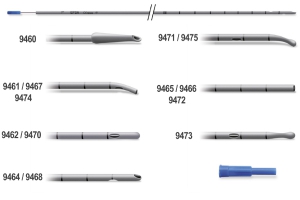UROLOGY > URETERAL CATHETER
URETERAL CATHETER
CODES: 9460 (chevassu) / 9461 (open, curved tip) / 9462 (cylindrical tip, one eye) / 9464 (bevelled tip, one eye) / 9465 (open tip, one eye) / 9466 (open tip, two eyes) / 9467 (open curved tip, one eye) / 9468 (bevelled tip, two eyes) / 9470 (cylindrical tip, two eyes) / 9471 (cylindrical, curved tip, 2 eyes) / 9472 (open tip) / 9473 (olive tip, two eyes) / 9474 (open, curved tip, two eyes) / 9475 (curved, cylindrical tip, one eye)
1 PUR catheter, with wide variety of tips, radiopaque, graduated in cm. (for diagnostic and therapeutic procedures).
1 guide wire made of stainless steel.
1 Luer connector
STERILE, SINGLE PACK, SINGLE USE.
Available sizes
Ch 3,0 / 4,0 / 5,0 / 6,0 / 7,0 / 8,0
EXCEPT CODE 9460 Ch 4,0 / 5,0 / 6,0 / 7,0 / 8,0
Recomen-
daciones
de uso
 Recommendation of a professional on the use of the technology.
Recommendation of a professional on the use of the technology.
The Ureteral Catheter is indicated with:
Diagnostic purpose:
– Carrying out contrasted imaging studies of the urinary excretory pathway (uretero-
retrograde renography), the Chevassu Ureteral Catheter being specifically indicated.
– Obtaining urine samples directly at the ureteral level for studies bacteriological, cytological, etc.
Therapeutic purpose:
– Congenital or acquired, intrinsic or extrinsic obstructive pathological processes, which they
compromise normal urinary flow through the ureter.
Causes of obstruction:
. intraluminal: urinary lithiasis: stones and grit; clots; strange bodies;
. parietal: tumors of the ureter; scars;
. extrinsic: compression by neighboring tumors; compression due to lymphadenopathy;
fibrosis retroperitoneal; ureter ligatures (iatrogenic).

